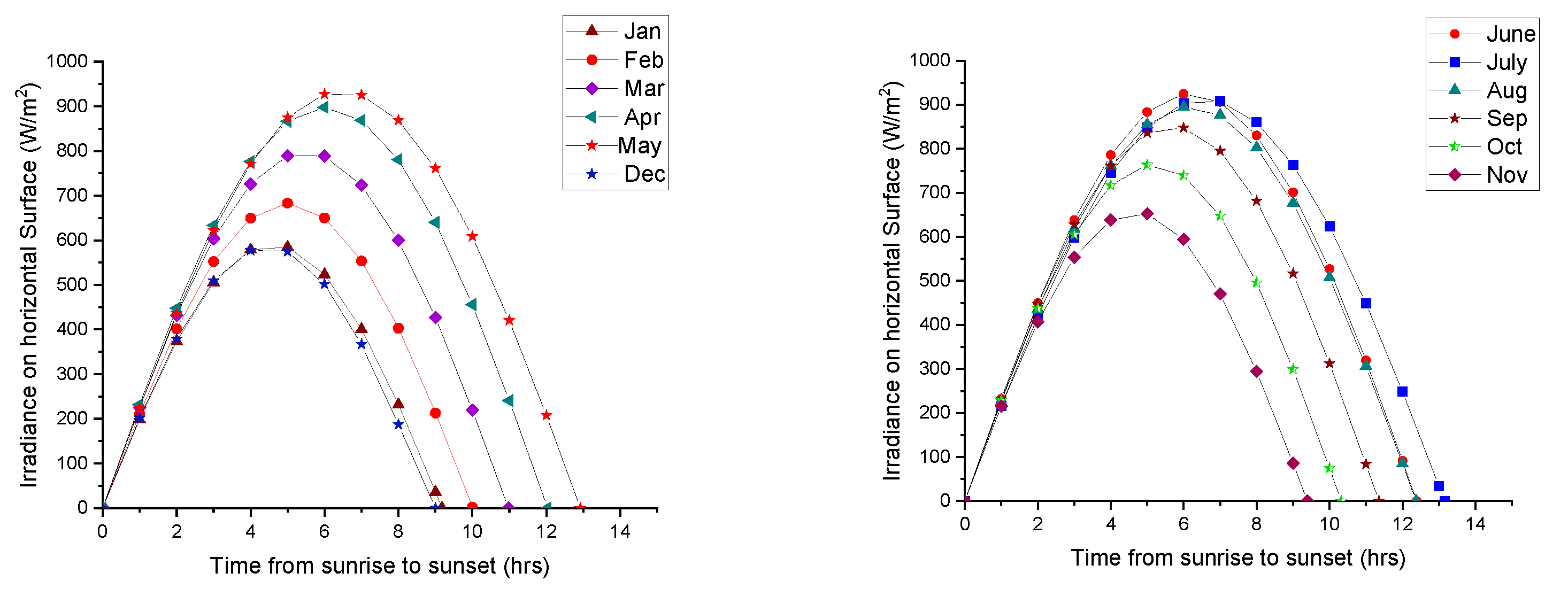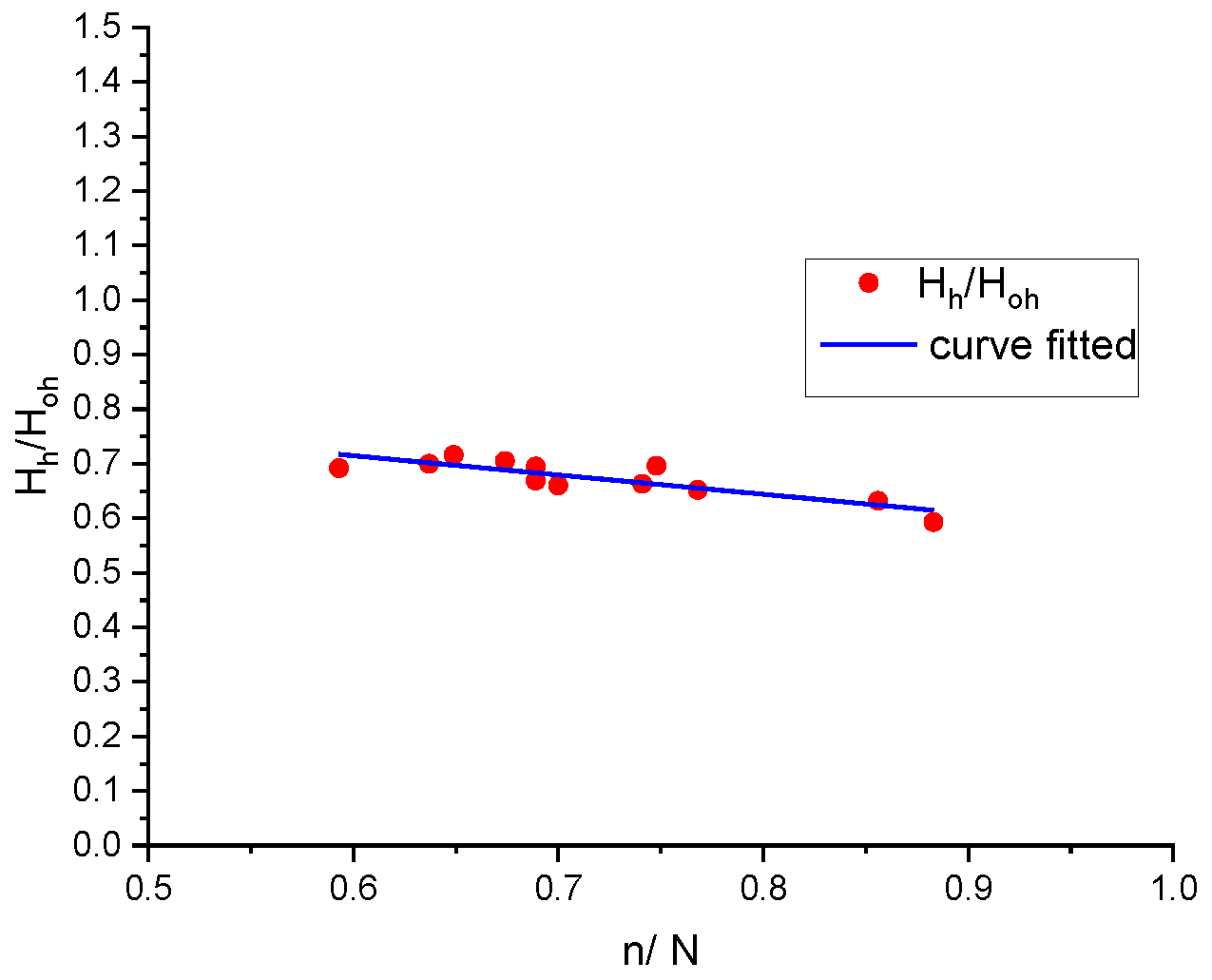Monthly Average Solar Radiation and Angstrom-Prescott Model for Islamabad, Pakistan †
Abstract
:1. Introduction
2. Monthly Average Solar Radiation
3. Angstrom–Prescott Model for Islamabad, Pakistan
4. Conclusions
Author Contributions
Funding
Institutional Review Board Statement
Informed Consent Statement
Data Availability Statement
Conflicts of Interest
References
- Akhter, P.; Baig, A.; Mufti, A. Clear Sky Solar Insolation Data for Islamabad. Int. J. Solar Energy 1991, 10, 155–159. [Google Scholar] [CrossRef]
- Ahmad, F.; Aqil Burney, S.M.; Husain, S.A. Monthly Average Daily Global Beam and Diffuse Solar Radiation and Its Correlation with Hours of Bright Sunshine for Karachi, Pakistan. Renew Energy 1991, 1, 115–118. [Google Scholar] [CrossRef]
- Gadiwala, M.S.; Usman, A.; Akhtar, M.; Jamil, K. Empirical Models for the Estimation of Global Solar Radiation with Sunshine Hours on Horizontal Surface in Various Cities of Pakistan. Pak. J. Meteorol. 2013, 9, 43–49. [Google Scholar]
- Ulfat, I.; Javed, F.; Abbasi, F.A.; Kanwal, F.; Usman, A.; Jahangir, M.; Ahmed, F. Estimation of Solar Energy Potential for Islamabad, Pakistan. Energy Procedia 2012, 18, 1496–1500. [Google Scholar] [CrossRef]
- Salima, G.; Chavula, G.M. Determining Angstrom Constants for Estimating Solar Radiation in Malawi. Int. J. Geosci. 2012, 3, 391–397. [Google Scholar] [CrossRef]
- Mousavi Maleki, S.A.; Hizam, H.; Gomes, C. Estimation of Hourly, Daily and Monthly Global Solar Radiation on Inclined Surfaces: Models Re-Visited. Energies 2017, 10, 134. [Google Scholar] [CrossRef]
- Twidell, J.; Weir, T. Renewable Energy Resources, 3rd ed.; Routledge: Abingdon-on-Thames, UK, 2015. [Google Scholar]
- Angstrom, A. Solar and Terrestrial Radiation. Q. J. R. Meteorol. Soc. 1924, 50, 121–126. [Google Scholar] [CrossRef]
- Weather and Climate, P. Average Monthly Hours of Sunshine in Islamabad. Available online: https://weather-and-climate.com/average-monthly-hours-Sunshine (accessed on 18 July 2022).


| Month | Average Sun Shine Month | n | N | n/N | Hh | Hoh | Hh/Hoh |
|---|---|---|---|---|---|---|---|
| (hr/Month) | (hr) | (hr) | (Global) | (Global) | (Global) | ||
| Calculated | Calculated | ||||||
| 1 | 196 | 6.323 | 9.18 | 0.688 | 561 | 839 | 0.668 |
| 2 | 189 | 6.750 | 10.2 | 0.661 | 674 | 956 | 0.705 |
| 3 | 202 | 6.516 | 10.98 | 0.593 | 762 | 1134 | 0.671 |
| 4 | 249 | 8.300 | 12.05 | 0.688 | 866 | 1246 | 0.695 |
| 5 | 311 | 10.032 | 12.93 | 0.775 | 928 | 1333 | 0.696 |
| 6 | 298 | 9.933 | 13.4 | 0.741 | 897 | 1352 | 0.663 |
| 7 | 260 | 8.387 | 13.17 | 0.636 | 912 | 1302 | 0.700 |
| 8 | 249 | 8.032 | 12.38 | 0.648 | 875 | 1222 | 0.716 |
| 9 | 262 | 8.733 | 11.37 | 0.768 | 793 | 1216 | 0.652 |
| 10 | 274 | 8.839 | 10.33 | 0.855 | 690 | 1091 | 0.632 |
| 11 | 249 | 8.300 | 9.4 | 0.882 | 555 | 936 | 0.592 |
| 12 | 194 | 6.258 | 8.93 | 0.700 | 489 | 836 | 0.584 |
| Month | n/N | Hh/Hoh (Global) Calculated | Hh/Hoh (Predict) | Error % |
|---|---|---|---|---|
| 1 | 0.688 | 0.668 | 0.683 | −1.476 |
| 2 | 0.661 | 0.705 | 0.692 | 0.012 |
| 3 | 0.593 | 0.671 | 0.717 | −0.045 |
| 4 | 0.688 | 0.695 | 0.683 | 0.011 |
| 5 | 0.775 | 0.696 | 0.652 | 0.043 |
| 6 | 0.741 | 0.663 | 0.664 | −0.001 |
| 7 | 0.636 | 0.700 | 0.701 | −0.001 |
| 8 | 0.648 | 0.716 | 0.697 | 0.018 |
| 9 | 0.768 | 0.652 | 0.655 | −0.003 |
| 10 | 0.855 | 0.632 | 0.624 | 0.008 |
| 11 | 0.882 | 0.592 | 0.614 | −0.021 |
| 12 | 0.700 | 0.584 | 0.679 | −0.094 |
| Month | H/Ho (Global) Calculated | H/Ho Predicted | H/Ho Predicted % Error | H/Ho Ulfat | H/Ho Ulfat % Error |
|---|---|---|---|---|---|
| 1 | 0.668 | 0.683 | −1.476 | 0.668 | 0.024 |
| 2 | 0.705 | 0.692 | 0.012 | 0.653 | 5.149 |
| 3 | 0.671 | 0.717 | −0.045 | 0.615 | 5.613 |
| 4 | 0.695 | 0.683 | 0.011 | 0.668 | 2.657 |
| 5 | 0.696 | 0.652 | 0.043 | 0.716 | −2.033 |
| 6 | 0.663 | 0.664 | −0.001 | 0.697 | −3.395 |
| 7 | 0.700 | 0.701 | −0.001 | 0.639 | 6.069 |
| 8 | 0.716 | 0.697 | 0.0185 | 0.646 | 6.966 |
| 9 | 0.652 | 0.655 | −0.003 | 0.712 | −6.007 |
| 10 | 0.632 | 0.624 | 0.008 | 0.760 | −12.807 |
| 11 | 0.592 | 0.614 | −0.021 | 0.775 | −18.266 |
| 12 | 0.584 | 0.679 | −0.094 | 0.675 | −9.013 |
Publisher’s Note: MDPI stays neutral with regard to jurisdictional claims in published maps and institutional affiliations. |
© 2022 by the authors. Licensee MDPI, Basel, Switzerland. This article is an open access article distributed under the terms and conditions of the Creative Commons Attribution (CC BY) license (https://creativecommons.org/licenses/by/4.0/).
Share and Cite
Hyder, M.J.; Nauman, A.; Musheer, S. Monthly Average Solar Radiation and Angstrom-Prescott Model for Islamabad, Pakistan. Eng. Proc. 2022, 23, 26. https://doi.org/10.3390/engproc2022023026
Hyder MJ, Nauman A, Musheer S. Monthly Average Solar Radiation and Angstrom-Prescott Model for Islamabad, Pakistan. Engineering Proceedings. 2022; 23(1):26. https://doi.org/10.3390/engproc2022023026
Chicago/Turabian StyleHyder, M. Javed, Asadullah Nauman, and Shams Musheer. 2022. "Monthly Average Solar Radiation and Angstrom-Prescott Model for Islamabad, Pakistan" Engineering Proceedings 23, no. 1: 26. https://doi.org/10.3390/engproc2022023026
APA StyleHyder, M. J., Nauman, A., & Musheer, S. (2022). Monthly Average Solar Radiation and Angstrom-Prescott Model for Islamabad, Pakistan. Engineering Proceedings, 23(1), 26. https://doi.org/10.3390/engproc2022023026






